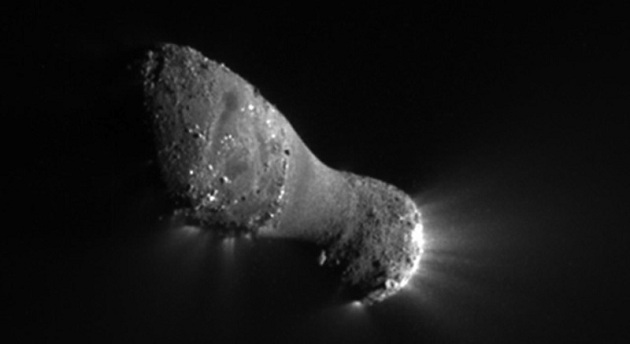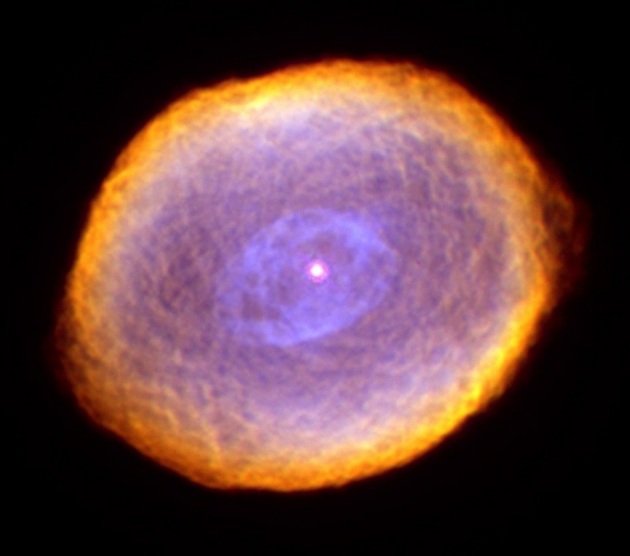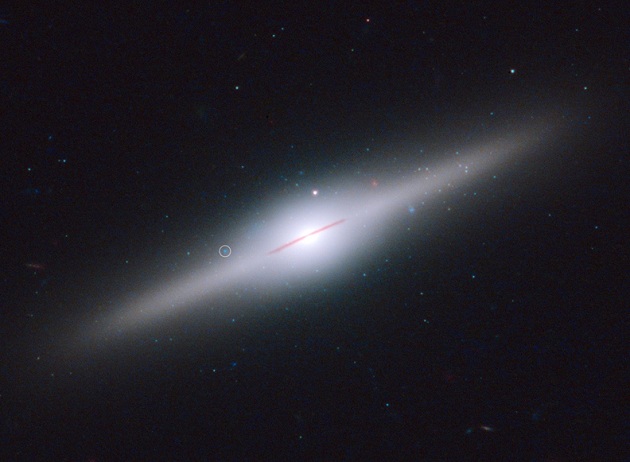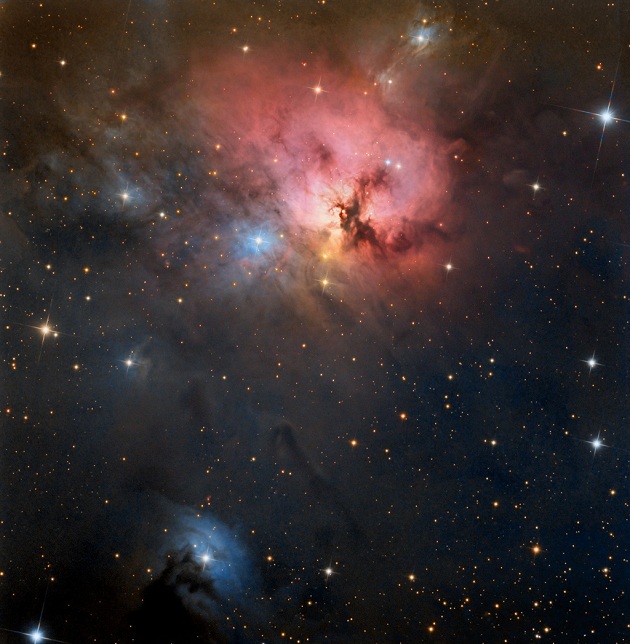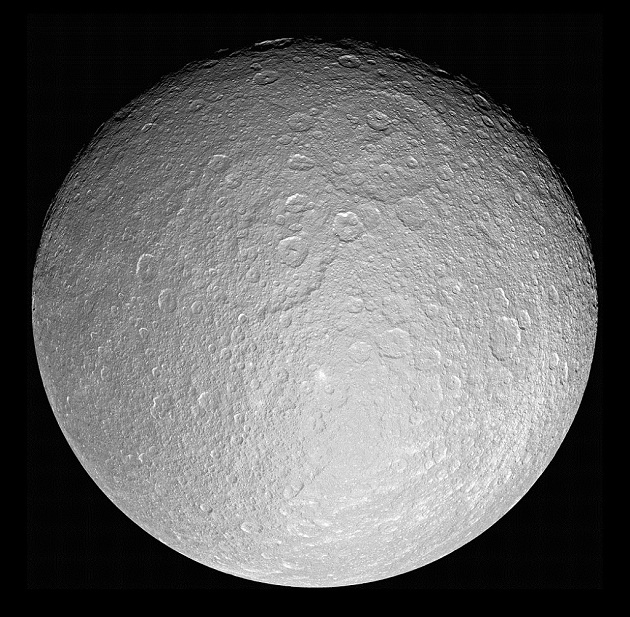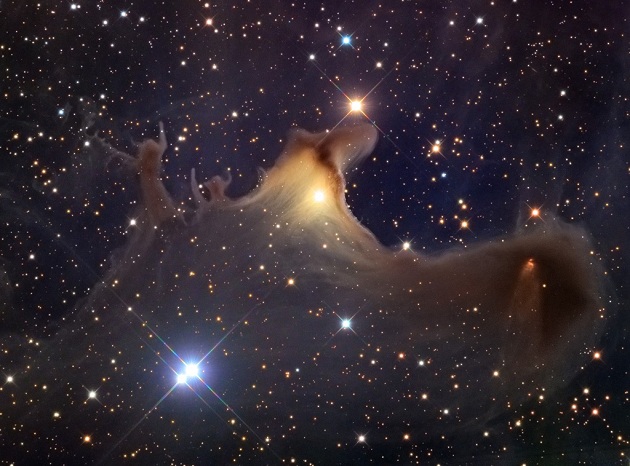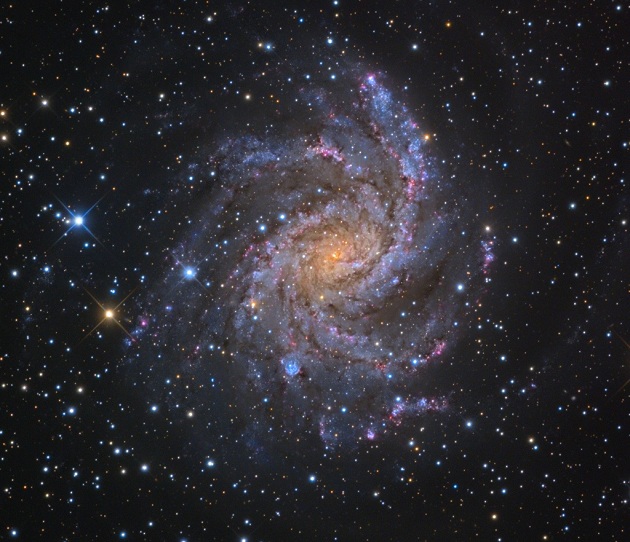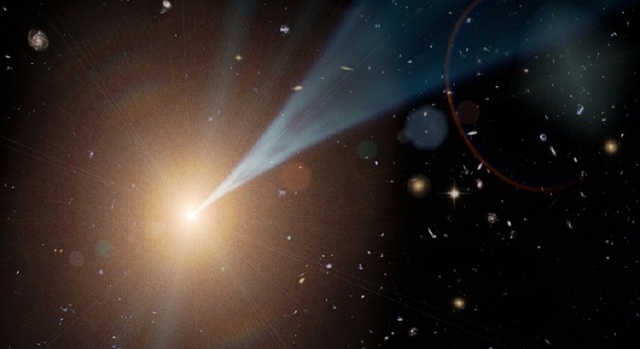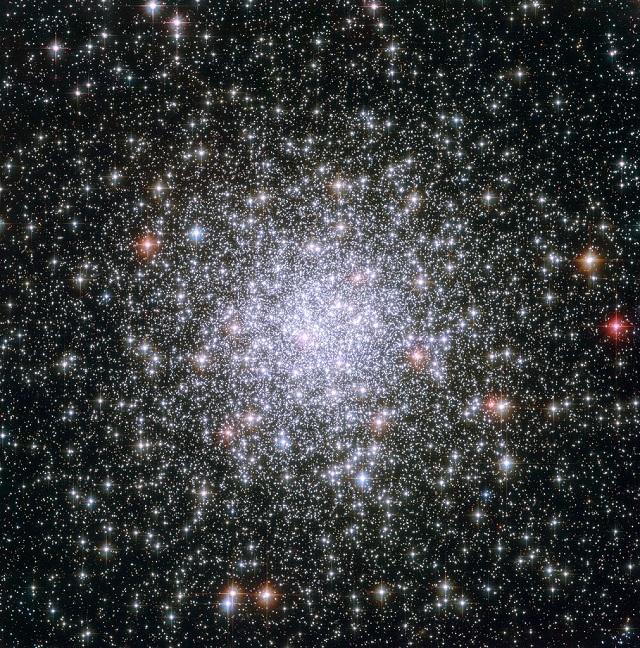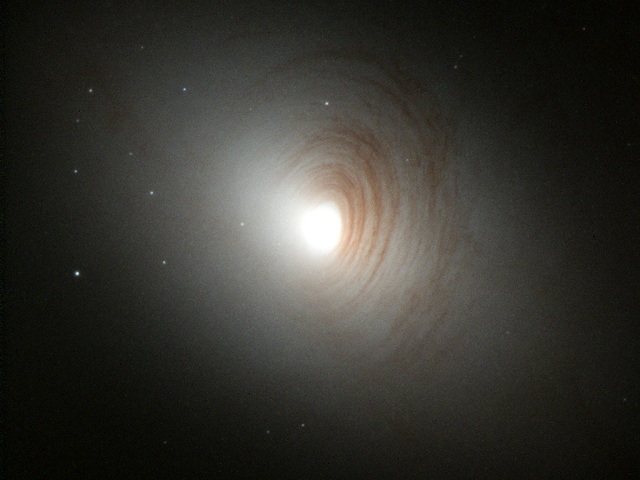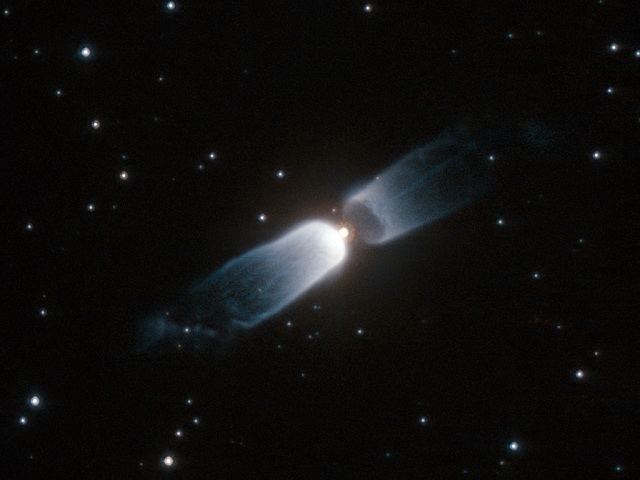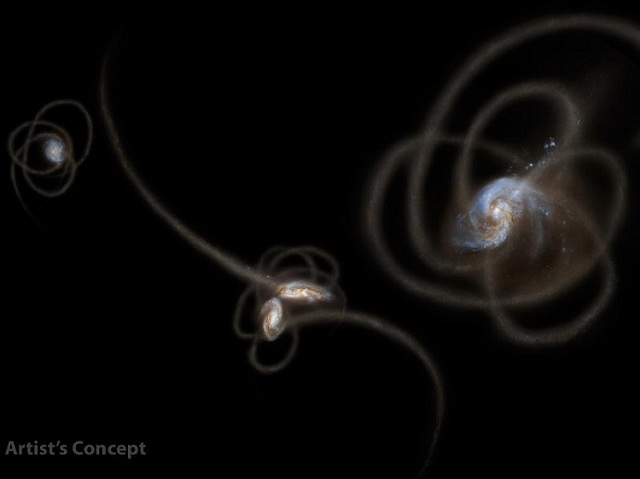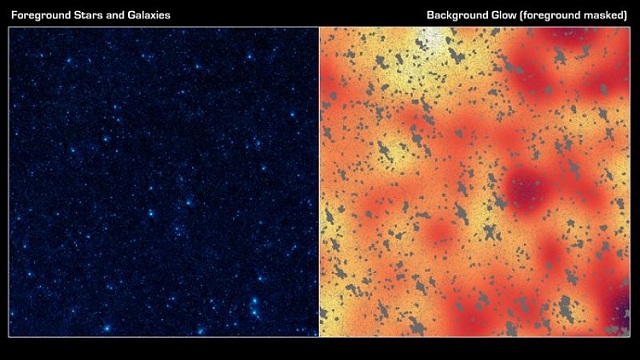
Posts by AnneliesRhemrev:
Anne’s Image of the Day: Comet Hartley 2
November 6th, 2012By Annelies Rhemrev
November 6, 2012
Comet Hartley 2, a small periodic comet
Image Credit: NASA/JPL-Caltech/UMD
Click here for a larger image.
Comet Hartley 2 (officially designated as 103P/Hartley) is a small periodic comet of about 1.2 to 1.6 kilometres (0.75 to 0.99 mi) in diameter, with an orbital period of 6.46 years. Its perihelion is near the Earth’s orbit at 1.05 AU from the Sun. The comet spins around one axis, but also tumbles around a different axis. It was discovered by Malcolm Hartley on March 15, 1986.
The comet passed within 0.12 AU (18 million km; 11 million mi) of Earth on 20 October 2010, only eight days before coming to perihelion (closest approach to the Sun) on 28 October 2010. Hartley 2 is estimated to come back to perihelion around 20 April 2017.
Hartley 2 is 2.25 kilometers (1.40 mi) long, and “peanut shaped”. Its nucleus is highly elongated and rotates over an 18-hour period. The nucleus has a radius of about 0.57 kilometers (0.35 mi) and a low albedo. The mass of the comet is estimated to be about 300 megatonnes (300,000,000,000 kg).
The comet has a smooth, relatively inactive middle region, or waist. On its rougher ends, the comet’s surface contains glittering, blocky objects that are about 50 meters (165 feet) high and 80 meters (260 feet) wide. These objects appear to be two to three times more reflective than the surface average.
Hartley 2 is a hyperactive comet, spewing out more water than other comets its size. When warmed by the Sun, dry ice (frozen carbon dioxide) deep in the comet’s body turns to gas jetting off the comet and dragging water ice with it. The comet should only be able to survive up to another 100 apparitions (around 700 years) at its current rate of mass loss.
Several jets of material are being ejected from the dark side of the comet, rather than the sunlit side. The rays coming off the rough ends consist of hundreds of tons of fluffy ice and dust chunks – the largest particles are of golf ball to basketball-size – and they are ejected by jets of carbon dioxide. The CO2 ice within the comet must be primordial, dating from the beginnings of the Solar System.
The strong activity in water release and carbon dioxide-powered jets didn’t occur equally in the different regions of the comet. The jets were seen at the ends of the comet, with most occurring at the small end. In the waist of the comet, water was released as vapor with very little carbon dioxide or ice.
Some of the dust, icy chunks, and other material coming off the ends of the comet are moving slowly enough to be captured by even the weak gravity of the comet. This material then falls back into the lowest point—the waist.
Despite its close passage by Earth’s orbit, the comet is not yet a known source of meteor showers. However, that could change. Dust trails from the recent returns of 103P/Hartley 2 move in and out of Earth’s orbit, and the 1979-dust trail is expected to hit in 2062 and 2068.
Hartley 2 was the target of a flyby of the Deep Impact spacecraft, as part of the EPOXI mission, on 4 November 2010, with closest approach of 694 kilometers (431 mi) of Hartley 2. This encounter was the fifth time a spacecraft from planet Earth has imaged a comet close-up.
See more images on Anne’s Astronomy News
Anne’s Image of the Day: NGC 2997
November 5th, 2012By Annelies Rhemrev
November 5, 2012
NGC 2997, a grand design spiral galaxy in Antlia
Image Credit & Copyright: Robert Gendler (http://www.robgendlerastropics.com/)
Click here for a larger image.
NGC 2997 is a bright, unbarred grand-design spiral galaxy, located about 40 million light-years away in the southern constellation Antlia (the Air pump). It is the brightest member of a group of galaxies of the same name in the Local Supercluster of galaxies along with the Local Group.
NGC 2997 contains hundreds of billions of stars and is thought to have a mass of about 100 billion times that of our Sun, but is probably less massive than our own Milky Way Galaxy. The galaxy is speeding away from us at about 1085 kilometers per second.
With a disk that is inclined 45 degrees to our line of sight, NGC 2997 has an oval appearance. The inner disk is covered with dust lanes, silhouetted against the central part of the galaxy, which shows a high surface brightness.
Like all grand design spirals, NGC 2997 has prominent and well-defined spiral arms, which appear to originate in the yellow nucleus. These sprawling arms are peppered with bright red blobs of ionized hydrogen which are regions of star formation, where the bright blue stars are born that generate most of the light in the arms of the galaxy.
Its small nucleus, that most likely hosts a supermassive black hole, also shows an interesting structure and concentrates an older population of yellowish stars. The nucleus is surrounded by a chain of hot giant clouds of ionized hydrogen.
See more images on Anne’s Astronomy News
Anne’s Image of the Day: The Spirograph Nebula
November 4th, 2012By Annelies Rhemrev
November 4, 2012
The Spirograph Nebula, a planetary nebula in Lepus
Image Credit: NASA and The Hubble Heritage Team (STScI/AURA). Acknowledgement: R. Sahai (JPL) et al.
Click here for a larger image.
The Spirograph Nebula (IC 418) is a bright planetary nebula of approximately 0.3 light-year across, located in the Milky Way Galaxy, some 2,000 light-years away in the constellation of Lepus. The nebula is moving away from us at about 62 kilometers per second.
The name derives from the strange, not well understood, texture of the nebula which resembles a pattern which can be created using the Spirograph, a toy which produces geometric patterns on paper.
Despite their name, planetary nebulae have nothing to do with planets. The name of planetary nebulae arose because of the visual similarity between some round planetary nebulae and the planets Uranus and Neptune when viewed through early telescopes.
A planetary nebula represents the final stage in the evolution of a star similar to our Sun. Only a few thousand years ago, the star at the center of the Spirograph Nebula was a red giant, but then ejected its outer layers into space to form this expanding nebula. The stellar remnant at the center is the hot core of the red giant. Over the next several thousand years, the nebula will gradually disperse into space, and then the star will cool and fade away for billions of years as a white dwarf. Our own Sun is expected to undergo a similar fate, but fortunately this will not occur until some 5 billion years from now.
Glowing like a multi-faceted jewel, the nebula’s luminosity is around 1500 times that of the Sun. The small, slightly elongated nebula consist of a filigree pattern and an inner ring. The star is off-center within the inner ring. The outer ring is subtly bi-polar, rather reminiscent of the Ring Nebula in Lyra, perhaps showing us what the Ring used to look like.
The patterns of the Spirograph are perhaps related to chaotic winds from the variable central star, which changes brightness unpredictably in just a few hours. The light from the central core excites surrounding atoms in the nebula causing them to glow. Still, the temperature of the central star is only about 35,000 K, what makes the star so “cool” that only about 75 percent of the nebular helium is ionized.
The small size of the nebula is consistent with the low star temperature of early evolution, as the star is still heating and the nebula growing, albeit at a low expansion rate of 12 kilometers per second.
This image was obtained with the Hubble Space Telescope. It is shown in a false-color representation, based on Wide Field Planetary Camera 2 exposures taken in February and September, 1999 through filters that isolate light from various chemical elements. Red shows emission from ionized nitrogen (the coolest gas in the nebula, located furthest from the hot nucleus), green shows emission from hydrogen, and blue traces the emission from ionized oxygen (the hottest gas, closest to the central star).
See more images on Anne’s Astronomy News
Anne’s Image of the Day: Galaxy ESO 243-49
November 3rd, 2012By Annelies Rhemrev
November 3, 2012
ESO 243-49, a large spiral galaxy in Phoenix
Image Credit: NASA, ESA and S. Farrell (University of Sydney)
Click here for a larger image.
ESO 243-49 is a large edge-on spiral galaxy, located about 290 million light-years away from Earth in the southern constellation Phoenix. It is speeding away from us at about 6639 kilometers per second.
Towards the edge of the galaxy, above the galactic plane, astronomers discovered in 2009 one of the first intermediate-mass black holes ever found, probably devouring a companion star. Known as HLX-1 (Hyper-Luminous X-ray source 1), the black hole, surrounded by a swirling disk of hot gas, has an estimated weight of about 20,000 solar masses. The black hole may be encircled by a massive cluster of young, blue stars of about 250 light-years across.
Such young clusters of stars are commonly found inside galaxies like the host galaxy, but not at their edges, as found with HLX-1. One possible scenario is that the HLX-1 black hole was the central black hole in a dwarf galaxy. The larger host galaxy may then have captured the dwarf. In this conjecture, most of the dwarf’s stars would have been stripped away through the collision between the galaxies. At the same time, new young stars would have formed in the encounter. The interaction that compressed the gas around the black hole would then have also triggered star formation.
The possible star cluster may be less than 200 million years old. This means that the bulk of the stars formed following the dwarf’s collision with the larger galaxy. The age of the stars tells how long ago the two galaxies crashed into each other.
The stars within the cluster can’t be resolved individually because the galaxy is too far away. Their presence is inferred from the color and brightness of the light coming from the black hole’s location. The brightness and color is consistent with other clusters of stars seen in other galaxies, but some of the light may be coming from the gaseous disk around the black hole.
HLX-1 brightens and fades over a period of roughly 367 days. Its X-ray brightness increases dramatically in about 10 days, falls slowly over the next 100-200 days, then stays low until the next flare-up.
A possible explanation is that the accretion disk is fed by a star in an elongated orbit. When the star comes closest, the black hole’s gravity pulls gas from its surface. The gas funnels into the accretion disk, heating the disk and causing it to emit a burst of X-rays. Over the next few months, the black hole ingests some of the gas, so the disk fades. HLX-1 may get sucked into the center of ESO 243-49, feeding its monstrous black hole eventually.
The discovery of the possible star cluster and the black hole has important implications for understanding the evolution of black holes and galaxies, because it had not been clear whether middleweight black holes formed inside ancient star clusters or by repeated mergers of small galaxies. This finding not only suggests they grew by mergers, but it also hints they will keep merging. That could explain another mystery – how supermassive black holes got so big.
This image is created by using NASA’s Hubble Space Telescope. The circle identifies a unique X-ray source that pinpoints the black hole.
See more images on Anne’s Astronomy News
Asteroid Belts at the Right Place Needed for Complex Life?
November 2nd, 2012By Annelies Rhemrev
Solar systems with life-bearing planets may be rare if they are dependent on the presence of asteroid belts of just the right mass, according to a study by Rebecca Martin, a NASA Sagan Fellow from the University of Colorado in Boulder, and astronomer Mario Livio of the Space Telescope Science Institute in Baltimore, Md.
This illustration shows three possible scenarios for the evolution of asteroid belts. In the top panel, a Jupiter-size planet migrates through the asteroid belt, scattering material and inhibiting the formation of life on planets. The second scenario shows our solar-system model: a Jupiter-size planet that moves slightly inward but is just outside the asteroid belt. In the third illustration, a large planet does not migrate at all, creating a massive asteroid belt. Material from the hefty asteroid belt would bombard planets, possibly preventing life from evolving. Image Credit: NASA/ESA/STScI
They suggest that the size and location of an asteroid belt, shaped by the evolution of the sun’s planet-forming disk and by the gravitational influence of a nearby giant Jupiter-like planet, may determine whether complex life will evolve on an Earth-like planet. This might sound surprising because asteroids are considered a nuisance due to their potential to impact Earth and trigger mass extinctions. But an emerging view proposes that asteroid collisions with planets may provide a boost to the birth and evolution of complex life.
Asteroids may have delivered water and organic compounds to the early Earth. According to the theory of punctuated equilibrium, occasional asteroid impacts might accelerate the rate of biological evolution by disrupting a planet’s environment to the point where species must try new adaptation strategies.
The astronomers based their conclusion on an analysis of theoretical models and archival observations, including infrared data from NASA’s Spitzer Space Telescope.
“Our study shows that only a tiny fraction of planetary systems observed to date seem to have giant planets in the right location to produce an asteroid belt of the appropriate size, offering the potential for life on a nearby rocky planet,” said Martin, the study’s lead author. “Our study suggests that our Solar System may be rather special.”
The findings will appear today in the Monthly Notices of the Royal Astronomical Society: Letters.
Martin and Livio suggest that the location of an asteroid belt relative to a Jupiter-like planet is not an accident. The asteroid belt in our Solar System, located between Mars and Jupiter, is a region of millions of space rocks that sits near the “snow line,” which marks the border of a cold region where volatile material such as water ice is far enough from the Sun to remain intact. When Jupiter formed just beyond the snow line, its powerful gravity prevented nearby material inside its orbit from coalescing and building planets.
Instead, Jupiter’s influence caused the material to collide and break apart. These fragmented rocks settled into an asteroid belt around the Sun.
“To have such ideal conditions you need a giant planet like Jupiter that is just outside the asteroid belt [and] that migrated a little bit, but not through the belt,” Livio explained. “If a large planet like Jupiter migrates through the belt, it would scatter the material. If, on the other hand, a large planet did not migrate at all, that, too, is not good because the asteroid belt would be too massive. There would be so much bombardment from asteroids that life may never evolve.”
Using our Solar System as a model, Martin and Livio proposed that asteroid belts in other solar systems would always be located approximately at the snow line. To test their proposal, Martin and Livio created models of planet-forming disks around young stars and calculated the location of the snow line in those disks based on the mass of the central star.
They then looked at all the existing space-based infrared observations from the Spitzer Space Telescope of 90 stars having warm dust, which could indicate the presence of an asteroid belt-like structure. The temperature of the warm dust was consistent with that of the snow line. “The warm dust falls right onto our calculated snow lines, so the observations are consistent with our predictions,” Martin said.
The duo then studied observations of the 520 giant planets found outside our Solar System. Only 19 of them reside outside the snow line. This suggests that most of the giant planets that may have formed outside the snowline have migrated too far inward to preserve the kind of slightly dispersed asteroid belt needed to foster enhanced evolution of life on an Earth-like planet near the belt. Apparently, less than four percent of the observed systems may actually harbor such a compact asteroid belt.
“Based on our scenario, we should concentrate our efforts to look for complex life in systems that have a giant planet outside of the snow line,” Livio said.
Source: Jet Propulsion Laboratory (JPL)
Read more articles on Anne’s Astronomy News
Anne’s Image of the Day: NGC 1579
November 2nd, 2012By Annelies Rhemrev
November 2, 2012
NGC 1579, a reflection and emission nebula in Perseus
Image Credit & Copyright: Adam Block/Mount Lemmon SkyCenter/University of Arizona (http://www.caelumobservatory.com/index.html)
Click here for a larger image.
NGC 1579 (also designated Sh2-222) is a dusty star forming region providing contrasting emission and reflection nebulae in the same field. It is some 3 light-years across, and located about 2,100 light-years away in the northern constellation Perseus. It resembles the better known Trifid Nebula (Messier 20), located in the southern sky. That’s why this nebula is often called “the Northern Trifid” or “Trifid of the North”.
This vast, dark cloud of dust and gas is one of the interstellar nurseries breeding new stars to light our Milky Way galaxy. NGC 1579 is lit it by an embedded, extremely young, massive star named LkHα 101, which is several times more massive the Sun and a strong emitter of the characteristic red hydrogen alpha light. This star lies within a small, young star cluster, together with dozens of sibling stars that are also newly formed.
The central region of NGC 1579 is glowing red of hydrogen gas excited by the hot stars whereas the blue regions are reflected starlight. Prominent dark dust lanes extend throughout the nebula. In fact, obscuring dust, pervasive in NGC 1579, is drastically dimming the visible light from the massive, young, hot stars still embedded in the cosmic cloud.
See more images on Anne’s Astronomy News
More Clues to Mars’ Wet Past
November 1st, 2012By Annelies Rhemrev
On 6 June, the high-resolution stereo camera on ESA’s Mars Express revisited the Argyre basin, this time aiming at Nereidum Montes, some 380 km northeast of Hooke crater. The stunning rugged terrain of Nereidum Montes marks the far northern extent of Argyre, one of the largest impact basins on Mars.
This computer-generated perspective view was created using data obtained from the High-Resolution Stereo Camera (HRSC) on ESA’s Mars Express. Centred at around 40°S and 310°E, the image has a ground resolution of about 23 m per pixel. This perspective view highlights many of the rippled sand dunes which form on the leeward (wind-sheltered) sides of mounds and canyons, as well as the lobate and fan-shaped surface around the impact crater which dominates the lower portion of the image. These features may indicate the previous extent of glaciation in the region, before a drier period in the planet’s history created the smooth plains. Taken during revolution 10736 on 6 June 2012. Credits: ESA/DLR/FU Berlin (G. Neukum)
Nereidum Montes stretches almost 1150 km and was named by the noted Greek astronomer Eugène Michel Antoniadi (1870–1944).
Based on his extensive observations of Mars, Antoniadi famously concluded that the ‘canals’ on Mars reported by Percival Lowell were, in fact, just an optical illusion.
High-Resolution Stereo Camera (HRSC) nadir and colour channel data taken during revolution 10736 on 6 June 2012 by ESA’s Mars Express have been combined to form a natural-colour view of Nereidum Montes. Centred at around 40°S and 310°E, the image has a ground resolution of about 23 m per pixel. It shows a portion of the extensive region, with concentric crater fill in many of the craters towards the east (lower part of the image). Undulations in crater floors are commonly seen in mid-latitude regions on Mars and are believed to be a result of glacial movement. Credits: ESA/DLR/FU Berlin (G. Neukum)
The images captured by Mars Express show a portion of the region, displaying multiple fluvial, glacial and wind-driven features.
Extensive dendritic drainage patterns, seen towards the north (lower right side) of the first and topographic images, were formed when liquid water drained into deeper regions within the area.
On Earth, tree-like channels of this kind are usually formed by surface runoff after significant rainfall, or when snow or ice melts. Similar processes are thought to have occurred on Mars in the distant past, when scientists now know there to have been water on the surface of the Red Planet.

Nereidum Montes seen in broader context at the northern edge of the Argyre basin. The smaller rectangle shows the region covered in this ESA Mars Express HRSC image release. Credits: NASA MGS MOLA Science Team
Several of the craters within the region, particularly in eastern parts (lower section) of the second image, show concentric crater fill, a distinctive martian process marked by rings of surface fluctuations within a crater rim.
The ratios between the diameter and depth of the filled craters suggest that there may still be water ice, possibly in the form of ancient glaciers, present below the dry surface debris cover.
Scientists have estimated that the water-ice depth in these craters varies from several tens up to hundreds of metres.
This colour-coded plan view is based on an ESA Mars Express HRSC digital terrain model of the region, from which the topography of the landscape can be derived. The colour coding enhances the visibility of the rippling sand dunes which formed in the wind-sheltered sides of the mounds and canyons. Centred at around 40°S and 310°E, the image has a ground resolution of about 23 m per pixel. Taken during revolution 10736 on 6 June 2012. Credits: ESA/DLR/FU Berlin (G. Neukum)
The largest crater on the south western side (top-left half) of the second and topographic images appears to have spilled out a glacier-like formation towards lower-lying parts of the region (shown as blue in the topographic image).
A smooth area to the east of (below) the glacial feature appears to be the youngest within the image, evidenced by an almost complete lack of cratering.

This computer-generated perspective view of Nereidum Montes was created using data obtained from the High-Resolution Stereo Camera (HRSC) on ESA’s Mars Express. Centred at around 40°S and 310°E, the image has a ground resolution of about 23 m per pixel. In the foreground near to the crater, a mud or ice-landslide is seen, possibly due to glacial processes. The striations along the slopes of both the right side of the inner crater wall and on the slopes of the range to the left of the crater indicate the presence of ice. Credits: ESA/DLR/FU Berlin (G. Neukum)
Another indication of subsurface water is seen in the fluidised ejecta blanket surrounding the crater at the northern edge (right-hand side) of the first and topographic images.
These ejecta structures can develop when a comet or asteroid hits a surface saturated with water or water ice.
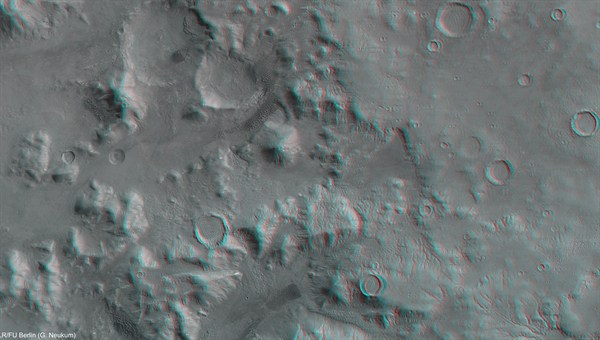
Nereidum Montes imaged during revolution 10736 on 6 June 2012 by ESA’s Mars Express using the High-Resolution Stereo Camera (HRSC). Data from HRSC’s nadir channel and one stereo channel have been combined to produce this anaglyph 3D image that can be viewed using stereoscopic glasses with red–green or red–blue filters. Centred at around 40°S and 310°E, the image has a ground resolution of about 23 m per pixel. Credits: ESA/DLR/FU Berlin (G. Neukum)
Finally, throughout the images and often near the wind-sheltered sides of mounds and canyons, extensive rippling sand dune fields are seen to have formed.
In-depth studies of regions such as Nereidum Montes play an essential role in unlocking the geological past of our terrestrial neighbour, as well as helping to find exciting regions for future robotic and human explorers to visit.
Source: The European Space Agency (ESA)
Read more stories on Anne’s Astronomy News
Anne’s Image of the Day: Saturn’s moon Rhea
November 1st, 2012By Annelies Rhemrev
November 1, 2012
Saturn’s moon Rhea
Image Credit: NASA/JPL/Space Science Institute
Click here for a larger image.
Rhea is, at 1,528 kilometers (949 miles) across, the second-largest moon of Saturn and the ninth largest moon in the Solar System. At a distance of 527,040 km (327,490 miles), Rhea orbits Saturn in a nearly perfect circle in 4 days 12 hours and 25 minutes, turning once on its axis during that time. The moon is tidally locked with its parent, what means that one side always faces toward Saturn.
It is an icy body with a density of 1.233 times that of liquid water (it is only the tenth-most-massive moon in the Solar System) what indicates that it is made of about 25% rock and 75% water ice. Probably Rhea lacks a rocky core. Thus, it is thought that this moon is composed of a homogenous mixture of ice and rock — a frozen dirty snowball. The temperature on Rhea is 99 K (−174 °C) in direct sunlight and between 73 K (−200 °C) and 53 K (−220 °C) in the shade. Rhea could sustain an internal liquid water ocean through heating by radioactive decay.
Rhea has a rather typical heavily cratered surface, with the exceptions of a few large fractures, caused by extensive tectonism, on the trailing hemisphere (the side facing away from the direction of motion along Rhea’s orbit) and a very faint “line” of material at Rhea’s equator that may have been deposited by material deorbiting from its rings (yes, Rhea might have a tenuous ring system).
The moon has two very large impact basins, which are about 400 and 500 km across. They are both covered in impact craters, indicating they are quite ancient. The more northerly and less degraded of the two is called Tirawa; the other one Mamaldi. There is also a 48 km-diameter impact crater that is prominent because of an extended system of bright rays. This crater, called Inktomi, is nicknamed “The Splat”, and may be one of the youngest craters on the inner moons of Saturn.
Its surface can be divided into two geologically different areas based on crater density; the first area contains craters which are larger than 40 km in diameter, whereas the second area, in parts of the polar and equatorial regions, has only craters under that size. This difference may indicate there was a major resurfacing event some time in Rhea’s history. However, it would have been long ago because there are few young craters with rays extending away from them (as on Earth’s Moon), and the average age of the plains is thought to be around four billion years old.
The leading hemisphere is heavily cratered and uniformly bright. The craters lack the high relief features seen on the Moon and Mercury. On the trailing hemisphere there is a network of bright streaks on a dark background with lengths of tens to hundreds of kilometers, often cutting through plains and craters. These wispy areas are subsidence fractures that make canyons (some of them several hundred meters high). The walls of those canyons are bright because darker material falls off them, exposing fresh bright water ice. These fracture cliffs show Rhea may have been tectonically active in its past, thus, in fact the streaks are tectonically formed ice cliffs.
Rhea has a thin atmosphere, more properly called an exosphere (where the atmosphere merges into space), consisting of oxygen and carbon dioxide in proportion of roughly 5 to 2. The main source of oxygen is water ice at its surface. The source of the carbon dioxide is less clear, but it may be related to oxidation of the organics present in ice or to outgassing of the moon’s interior.
On March 6, 2008, NASA announced that as Cassini passed by Rhea it discovered a tenuous ring system. This would mark the first discovery of rings about a moon. Unfortunately, a careful search later on failed to find any evidence of rings. Astronomers still don’t agree about how to explain the data which suggested their existence.
The first images of Rhea were obtained by Voyager 1 & 2 spacecraft in 1980–1981. After that, there were four close targeted fly-bys by the Cassini orbiter: at a distance of 500 km in November 2005, at 5,750 km in August 2007, at 100 km in March 2010 and at 69 km in January 2011. Rhea has been also imaged many times from long to moderate distances by the orbiter.
This image is Cassini view of Rhea’s anti-Saturnian hemisphere, showing the moon’s two largest impact basins (Mamaldi above and left of center, and adjacent Tirawa to its upper right).
See more images on Anne’s Astronomy News
Anne’s Image of the Day: The Ghost Nebula
October 31st, 2012By Annelies Rhemrev
October 31, 2012
The Ghost Nebula, a reflection nebula in Cepheus
Image Credit & Copyright: Adam Block/Mount Lemmon SkyCenter/University of Arizona (http://www.caelumobservatory.com/index.html)
Click here for a larger image.
With this cosmic ghost I’m wishing you all a happy and spooky Halloween!
The Ghost Nebula (designated Sharpless 2-136 (Sh2-136) and vdB 141) is a rather isolated reflection nebula over 2 light-years across, located some 1200 light-years away at the edge of the Cepheus Flare molecular cloud complex in the constellation Cepheus.
It is nicknamed the “Ghost Nebula” due its spooky appearance and to several human-like figures with arms raised, rising up from the top of the cloud structure to the left of the bright reflection.
The complex process of star formation create dust clouds of many shapes and sizes. In the case of the Ghost nebula, spooky shapes seem to haunt this starry expanse drifting through the night. Of course, these shapes are also cosmic dust clouds. Several stars are embedded in the nebula, and their light gives it a ghoulish brown color.
Also cataloged as Bok globule CB230, the core of the dark cloud on the right side of this image is collapsing and is likely a binary star system in the early stages of formation, identified as BD+67 1300.
Bok globules are dark clouds of dense cosmic dust and gas within star-forming regions in which usually star formation takes place. They most commonly result in the formation of double or multiple star systems.
The name Sharpless comes from a catalog of 312 emission nebulae (H II regions). The first edition was published by Stewart Sharpless in 1953 with 142 objects (Sh1) and the second and final version was published in 1959 with 312 objects (Sh2). The “vdB” stands for “van den Bergh”; vdB 141 is reflection nebula number 141 in Sidney van den Bergh’s Catalog of Reflection Nebulae, created in 1966.
North is to the bottom… it looks much better upside down 😉
See more images on Anne’s Astronomy News
Anne’s Image of the Day: The Fireworks Galaxy
October 30th, 2012By Annelies Rhemrev
October 30, 2012
The Fireworks Galaxy, a spiral galaxy in Cepheus and Cygnus
Image Credit & Copyright: Adam Block/Mount Lemmon SkyCenter/University of Arizona (http://www.caelumobservatory.com/index.html)
Clich here for a larger image
Today it’s my birthday, so let’s have a party… with fireworks!!
The Fireworks Galaxy (also known as NGC 6946, Arp 29, or Caldwell 12) is an intermediate spiral galaxy of about 20,000 light-years across, located just some 10 million light-years away, on the border between the constellations of Cepheus and Cygnus, and is moving away from us at approximately 45 kilometers per second.
The galaxy is undergoing a tremendous burst of star formation with no obvious cause. In many cases spirals light up when interacting with another galaxy, but this galaxy appears relatively isolated in space. An explanation for the high star formation rate is the recent accretion of many primordial low-mass neutral hydrogen clouds from the surrounding region.
The center of the Fireworks galaxy is home to a nuclear starburst itself, and picturesque dark dust lanes are seen lacing the disk, and it has widespread high-velocity clouds associated with the disk. The colors of the galaxy change from the yellowish light of old stars in the center to young, bright blue star clusters and reddish star-forming regions along its spiral arms. has widespread high-velocity clouds associated with the disc
NGC 6946 is called the “Fireworks Galaxy” because so many supernovae have been spotted there in the last hundred years. Nine supernovae (SN 1917A, SN 1939C, SN 1948B, SN 1968D, SN 1969P, SN 1980K, SN 2002hh, SN 2004et, and SN 2008S) have been observed in the galaxy. With this number of supernovae, NGC 6946 is leading the statistics, just one SN more than follow-up M83, the Southern Pinwheel galaxy.
The Fireworks galaxy is highly obscured by interstellar matter of our own Milky Way galaxy, as it is quite close to the galactic plane.
See more images on Anne’s Astronomy News
Blazars Still Mysterious Cosmic Objects
October 29th, 2012By Annelies Rhemrev
A blazar is a galaxy with an intensely bright central nucleus containing a supermassive black hole, much like a quasar. The difference is that a blazar can emit light with extremely high energy gamma rays that are sometimes over a hundred million times more energetic than the highest energy X-rays that the Chandra X-ray Observatory studies. The overall emission of a blazar also varies dramatically with time and all known blazars are bright at radio wavelengths.
Astronomers suspect that the bizarre behavior of blazars results when matter falling onto the vicinity of the supermassive black hole erupts into powerful, narrow beams of high velocity charged particles. The intense X-ray, gamma ray, and infrared emission we see, and the variability as well, are thought to be the results of our fortuitously staring right down the throats of the jets. In most other galaxies, infrared radiation comes from dust heated either by star formation or ultraviolet radiation from the vicinity of the massive black hole, rather than a blazar jet.
CfA astronomers Allesandro Paggi, Raffaele D’Abrusco, Jonathan Grindlay, and Howard Smith, and their colleagues recently published a new method to find and study blazars. They discovered that the infrared colors of blazars, as measured by the recent WISE survey satellite, are so unusual that objects with these colors are very likely to be blazars. Ninety-seven percent of known blazars were easily picked out from thousands of other WISE sources by their infrared colors.
There are about 1873 known gamma ray sources. About one-third of them are quite mysterious, in part because their very imprecise spatial locations have not allowed them to be associated with particular galaxies that can be studied with optical telescopes. The CfA astronomers discovered that about half of unknown gamma-ray sources could reasonably be identified with infrared emitting blazars, with the far more precise WISE coordinates then allowing detailed follow-up observations.
One unidentified gamma-ray source recently flared, prompting the team to see if it too had an infrared blazar-like color counterpart consistent with its location. Indeed there was one. The mystery, however, is that the counterpart is not a known blazar, nor does it have typical blazar properties despite having typical blazar infrared colors: it has no radio emission, it is not known to vary, and although it is an X-ray emitter, the rest of its broad distribution of energy is unlike that of most blazars. It is possible that another galaxy nearby is actually the gamma-ray counterpart, but all of the candidates show other discrepancies inconsistent with blazar behavior.
If the WISE source is in fact the counterpart to the gamma-ray burst, the absence of radio emission means that it represents a mysterious new class of extragalactic source that somehow suppresses radio emission. If it is not the counterpart, its lack of radio emission is still a blazar mystery. Further research is needed to resolve the mystery, but the work so far illustrates the powerful capabilities of multi-wavelength research.
Source: Harvard-Smithsonian Center for Astrophysics (CfA)
Read more stories on Anne’s Astronomy News
Anne’s Image of the Day: Messier 69
October 29th, 2012By Annelies Rhemrev
October 29, 2012
Messier 69, a globular cluster in Sagittarius
Image Credit: ESA/Hubble & NASA
Click here for a larger image.
Messier 69 (also known as NGC 6637) is a globular cluster of roughly 85 light-years across, with an estimated mass of 300,000 solar masses and an age of 13.06 billion years. It is located some 29,700 light-years away in the constellation Sagittarius (the Archer), quite close to the galactic center (only about 6,200 light-years distant), and is moving away from Earth at approximately 39.1 kilometers per second.
Globular clusters are dense collections of old stars. Messier 69, rather similar to its neighbor Messier 70 (with only 1,800 light-years separating the two objects), is one of the smaller and fainter globular clusters in Messier’s catalog.
Despite its age, Messier 69 is one of the most metal-rich globular clusters known. In astronomy, the term “metal” refers to any element heavier than the two most common elements in our Universe, hydrogen and helium. The nuclear fusion that powers stars created all of the metallic elements in nature, from the calcium in our bones to the carbon in diamonds. Successive generations of stars have, via supernova explosions at the end of their lives, built up the metallic abundances we see today.
Because the stars in globular clusters are ancient, their metallic abundances are much lower than more recently formed stars, such as the Sun. Studying the makeup of stars in globular clusters like Messier 69 has helped astronomers trace back the evolution of the cosmos.
In this picture, foreground stars look big and golden when set against the backdrop of the thousands of white, silvery stars that make up M69.
The image is made by the NASA/ESA Hubble Space Telescope, and is a combination of exposures taken in visible and near-infrared light by Hubble’s Advanced Camera for Surveys.
See more images on Anne’s Astronomy News
Anne’s Image of the Day: NGC 2787
October 28th, 2012By Annelies Rhemrev
October 28, 2012
NGC 2787, a lenticular galaxy in Ursa Major
Image Credit: M. Carollo (Swiss Federal Institute of Technology, Zurich), NASA and The Hubble Heritage Team (STScI/AURA)
Click here for a larger image.
NGC 2787 is a barred lenticular galaxy of about 4500 light-years across, located approximately 24 million light-years away in the constellation Ursa Major. It is moving away from us at about 696 kilometers per second.
Lenticular galaxies are lens-shaped galaxies and, like spiral galaxies, they contain a disk, but like elliptical galaxies, they are usually short on dust and gas. They show little or no evidence of the grand spiral arms that occur in their more photogenic cousins. Lenticulars are relatively little studied, possibly because of their seemingly benign nature.
However, despite NGC 2787’s seemingly bland qualities astronomers did take a look at the center of this galaxy in order to understand what happens in the center and to help determine how lenticular galaxies formed, including the role of galaxy collisions and central black holes.
Pictures and evidence indicate that lenticulars can be both photogenic and scientifically interesting after all. For example, the above image of NGC 2787. Although the galaxy has no appreciable spiral structure or ongoing star formation, this image shows that the center of this lenticular galaxy does have an interesting structure. It contains a faint bar (not apparent in this image) and a bright nucleus, encircled with tightly wound, almost concentric, arms of dark dust.
Measurements of the speed of gas quite near the center of the galaxy show that it is accelerated to high speed, probably by a supermassive black hole that is quietly consuming small amounts of matter. Astronomers study this black hole to learn more about the relationship between supermassive black holes and their parent galaxies. NGC 2787 may be in the latest stages of an ultra-luminous infrared galaxy (ULIRG).
There are about a dozen globular clusters hovering around NGC 2787 visible in this image. What appear to be stars are, in fact, gravitationally bound families of hundreds of thousands of ancient stars orbiting the center of the galaxy.
This image was made with the Hubble Space Telescope using Hubble’s Wide Field Planetary Camera 2 in January 1999, by combining light from blue, green and infrared filters.
See more images on Anne’s Astronomy News
Anne’s Image of the Day: IRAS 13208-6020
October 27th, 2012By Annelies Rhemrev
October 27, 2012
IRAS 13208-6020, a protoplanetary nebula in Centaur
Image Credit: ESA/Hubble & NASA
Click here for a larger image.
IRAS 13208-6020 is a bipolar protoplanetary nebula in the constellation Centaur, formed from material that is shed by a dying central star. The nebula has two very similar outflows of material in opposite directions and a clearly visible dusty ring surrounding the central star.
Protoplanetary nebulae are clouds of dust and gas formed from material shed by an aging central star similar in mass to our Sun. For such a star death is a long process. After billions of years, the hydrogen fuel that powers the star begins to run out. The star balloons to great size and becomes a red giant. Then the core shrinks and heats up. At the same time the star ejects its cooler outer layers, enveloping itself in clouds of gas, but the core is not yet hot enough to make the gas itself glow on its own. Instead, the gas is merely reflecting the light from the star.
But as the star continues to evolve, it becomes hot enough to emit strong ultraviolet light. At that point it will have the power needed to make the gas glow, and will become a real full-fledged planetary nebula. But before the nebula begins to shine, fierce winds of material ejected from the star will continue to shape the surrounding gas into intricate patterns that can only be truly appreciated later once the nebula begins to glow. All that is left after this process is the exposed, hot and dead core, known as a white dwarf.
A protoplanetary nebula is a relatively short-lived phenomenon, so finding one is a rare opportunity for astronomers to learn more about them and to observe the beginning of the formation of planetary nebulae (hence the name protoplanetary, or preplanetary nebulae).
Despite their name, planetary nebulae and (thus) protoplanetary nebulae have nothing to do with planets. The name of planetary nebulae arose because of the visual similarity between some round planetary nebulae and the planets Uranus and Neptune when viewed through early telescopes.
Although there are lots of (proto)planetary nebulae shaped like IRAS 13208-6020, with twin outflows of material resembling a butterfly, its shape is really strange. A star all alone in space would normally emit gas in a rough sphere around itself, but in this case something is shaping the wind. Most likely it’s some sort of companion: a star orbiting very close in, perhaps. Or, it’s possible that the central star had planets, and as it was dying it expanded, engulfing those planets. As they orbited inside the star, frying the whole time, they would help accelerate the star’s spin. That too could produce the bipolar shape of the gas around the star.
This picture was created from images taken with the NASA/ESA Hubble Space Telescope, using the High Resolution Channel of Hubble’s Advanced Camera for Surveys. Images taken in visible light and in infrared light have been combined to create this picture.
Usually, (proto)planetary nebulae are faint in the infrared, but this one is quite bright in that light; the gas itself doesn’t emit much infrared light, but the star sure does, and the gas is reflecting it.
See more images on Anne’s Astronomy News
The Revival of a ‘Dead’ Exoplanet: Zombie Fomalhaut B
October 26th, 2012By Annelies Rhemrev
A second look at data from NASA’s Hubble Space Telescope is reanimating the claim that the nearby star Fomalhaut hosts a massive exoplanet. The study suggests that the planet, named Fomalhaut b, is a rare and possibly unique object that is completely shrouded by dust.
Fomalhaut, the brightest star in the constellation Piscis Austrinus. Image Credit: NASA, ESA, P. Kalas and J. Graham (University of California, Berkeley) and M. Clampin (NASA GSFC)
Fomalhaut is the brightest star in the constellation Piscis Austrinus and lies 25 light-years away.
In November 2008, Hubble astronomers announced the exoplanet, named Fomalhaut b, as the first one ever directly imaged in visible light around another star. The object was imaged just inside a vast ring of debris surrounding but offset from the host star. The planet’s location and mass — no more than three times Jupiter’s — seemed just right for its gravity to explain the ring’s appearance.
Recent studies have claimed that this planetary interpretation is incorrect. Based on the object’s apparent motion and the lack of an infrared detection by NASA’s Spitzer Space Telescope, they argue that the object is a short-lived dust cloud unrelated to any planet.
A new analysis, however, brings the planet conclusion back to life.
“Although our results seriously challenge the original discovery paper, they do so in a way that actually makes the object’s interpretation much cleaner and leaves intact the core conclusion, that Fomalhaut b is indeed a massive planet,” said Thayne Currie, an astronomer formerly at NASA’s Goddard Space Flight Center in Greenbelt, Md., and now at the University of Toronto.

This visible-light image from the Hubble Space Telescope shows the vicinity of the star Fomalhaut, including the location of its dust ring and disputed planet, Fomalhaut b. A coronagraphic mask helped dim the star’s brightness. This view combines two 2006 observations that were taken with masks of different sizes (1.8 and 3 arcseconds). Image Credit: NASA/ESA/T. Currie, U. Toronto
The discovery study reported that Fomalhaut b’s brightness varied by about a factor of two and cited this as evidence that the planet was accreting gas. Follow-up studies then interpreted this variability as evidence that the object actually was a transient dust cloud instead.
In the new study, Currie and his team reanalyzed Hubble observations of the star from 2004 and 2006. They easily recovered the planet in observations taken at visible wavelengths near 600 and 800 nanometers, and made a new detection in violet light near 400 nanometers. In contrast to the earlier research, the team found that the planet remained at constant brightness.
The team attempted to detect Fomalhaut b in the infrared using the Subaru Telescope in Hawaii, but was unable to do so. The non-detections with Subaru and Spitzer imply that Fomalhaut b must have less than twice the mass of Jupiter.
Another contentious issue has been the object’s orbit. If Fomalhaut b is responsible for the ring’s offset and sharp interior edge, then it must follow an orbit aligned with the ring and must now be moving at its slowest speed. The speed implied by the original study appeared to be too fast. Additionally, some researchers argued that Fomalhaut b follows a tilted orbit that passes through the ring plane.
Using the Hubble data, Currie’s team established that Fomalhaut b is moving with a speed and direction consistent with the original idea that the planet’s gravity is modifying the ring.

This is an artist’s impression of the exoplanet, Fomalhaut b, orbiting its sun, Fomalhaut. Image Credit: ESA; Hubble, M. Kornmesser; and ESO, L. Calçada and L. L. Christensen
“What we’ve seen from our analysis is that the object’s minimum distance from the disk has hardly changed at all in two years, which is a good sign that it’s in a nice ring-sculpting orbit,” explained Timothy Rodigas, a graduate student in the University of Arizona and a member of the team.
Currie’s team also addressed studies that interpret Fomalhaut b as a compact dust cloud not gravitationally bound to a planet. Near Fomalhaut’s ring, orbital dynamics would spread out or completely dissipate such a cloud in as little as 60,000 years. The dust grains experience additional forces, which operate on much faster timescales, as they interact with the star’s light.
“Given what we know about the behavior of dust and the environment where the planet is located, we think that we’re seeing a planetary object that is completely embedded in dust rather than a free-floating dust cloud,” said team member John Debes, an astronomer at the Space Telescope Science Institute in Baltimore, Md.
A paper describing the findings has been accepted for publication in The Astrophysical Journal Letters.
Because astronomers detect Fomalhaut b by the light of surrounding dust and not by light or heat emitted by its atmosphere, it no longer ranks as a “directly imaged exoplanet.” But because it’s the right mass and in the right place to sculpt the ring, Currie’s team thinks it should be considered a “planet identified from direct imaging.”
Fomalhaut was targeted with Hubble most recently in May by another team. Those observations are currently under scientific analysis and are expected to be published soon.
Source: The National Aeronautics and Space Administration (NASA)
Read more stories on Anne’s Astronomy News
Anne’s Image of the Day: The Cartwheel Galaxy
October 26th, 2012By Annelies Rhemrev
October 26, 2012
The Cartwheel Galaxy, a ring galaxy in Sculptor
Image Credit: ESA/Hubble & NASA
Click here for a larger image.
The Cartwheel Galaxy (ESO 350-40) is a ring galaxy of some 150,000 light-years across (which is slightly larger than our Milky Way galaxy), located 496 million light-years away in the southern constellation Sculptor. It is speeding away from us at about 9050 kilometers per second and rotates at 217 kilometers per second. The galaxy has a mass of about 3.85 billion solar masses.
Previously, scientists believed the bright blue ring marked the outermost edge of the galaxy, but the latest observations detect a faint disk, not visible in this image, that extends to twice the diameter of the ring. This means the Cartwheel is a monstrous 2.5 times the size of the Milky Way.
The blue ring of starburst reveals billions of newly born stars, caused by a rare and spectacular head-on collision with a smaller companion approximately 200 million years ago (i.e., 200 million years prior to the image).
When the nearby intruder galaxy — possibly one of the two galaxies on the left side of the image — passed through the Cartwheel Galaxy, the force of the collision caused a powerful shock wave through the galaxy, much like the ripples produced when a stone is dropped into a lake.
Moving at the high speed of more than 300,000 km per hour, the shock wave swept up gas and dust, producing the expanding starburst ring around the galaxy’s center. The most recent star burst (star formation due to compression waves) has lit up the outermost ring of the Cartwheel.
Star formation via starbursts result in the formation of massive and extremely luminous stars. When these stars explode as supernovae, they leave behind neutron stars and black holes. Some of these neutron stars and black holes have nearby companion stars, and become powerful X-ray sources as they pull matter off their companions.
While most galaxies have only one or two bright X-ray sources, the Cartwheel contains an exceptionally large number of them. The brightest X-ray sources in the Cartwheel are likely black holes with companion stars, and appear as the white dots that lie along the rim of the image, because many massive stars formed in the rim.
The Cartwheel Galaxy was once a normal spiral galaxy similar to our home galaxy, the Milky Way, before it underwent the collision, with spiral arms winding outward from the galaxy’s center. The galaxy is beginning to take the form of a normal spiral galaxy again, as seen in the faint arms or spokes between the outer ring and the bulls-eye shaped nucleus.
Usually a galaxy is brighter toward the center, but the collision actually smoothed out the interior of the galaxy, concentrating older stars and dust into the inner regions, like the calm after the storm of star formation.
The Cartwheel Galaxy is one of the most dramatic examples of the small class of ring galaxies, and it is an unusual opportunity to study new stars, because many stars would ordinarily take much longer to form.
This image was taken with the NASA/ESA Hubble Space Telescope.
See more images on Anne’s Astronomy News
Mysterious Infrared Background Glow Comes From Stray Stars
October 25th, 2012By Annelies Rhemrev
A new study using data from NASA’s Spitzer Space Telescope suggests a cause for the mysterious glow of infrared light seen across the entire sky. It comes from isolated stars beyond the edges of galaxies. These stars are thought to have once belonged to the galaxies before violent galaxy mergers stripped them away into the relatively empty space outside of their former home.
New research from scientists using NASA’s Spitzer Space Telescope suggests that a mysterious infrared glow across our whole sky is coming from stray stars torn from galaxies. When galaxies grow, they merge and become gravitationally tangled in a violent process that results in streams of stars being ripped away from the galaxies. Such streams, called tidal tails, can be seen in this artist’s concept. Scientists say that Spitzer is picking up the collective glow of stars such as these, which linger in the spaces between galaxies. This artwork is adapted, in part, from galaxy images obtained from the NASA/ESA Hubble Space Telescope. Image Credit: NASA/JPL-Caltech
“The infrared background glow in our sky has been a huge mystery,” said Asantha Cooray of the University of California at Irvine, lead author of the new research published in the journal Nature. “We have new evidence this light is from the stars that linger between galaxies. Individually, the stars are too faint to be seen, but we think we are seeing their collective glow.”
The findings disagree with another theory explaining the same background infrared light observed by Spitzer. A group led by Alexander “Sasha” Kashlinsky of NASA’s Goddard Space Flight Center in Greenbelt, Md., proposed in June this light, which appears in Spitzer images as a blotchy pattern, is coming from the very first stars and galaxies.
In the new study, Cooray and colleagues looked at data from a larger portion of the sky, called the Boötes field, covering an arc equivalent to 50 full Earth moons. These observations were not as sensitive as those from the Kashlinsky group’s studies, but the larger scale allowed researchers to analyze better the pattern of the background infrared light.
“We looked at the Boötes field with Spitzer for 250 hours,” said co-author Daniel Stern of NASA’s Jet Propulsion Laboratory in Pasadena, Calif. “Studying the faint infrared background was one of the core goals of our survey, and we carefully designed the observations in order to directly address the important, challenging question of what causes the background glow.”
The team concluded the light pattern of the infrared glow is not consistent with theories and computer simulations of the first stars and galaxies. Researchers say the glow is too bright to be from the first galaxies, which are thought not to have been as large or as numerous as the galaxies we see around us today. Instead, the scientists propose a new theory to explain the blotchy light, based on theories of “intracluster” or “intrahalo” starlight.
The image on the left shows a portion of our sky, called the Boötes field, in infrared light, while the image on the right shows a mysterious, background infrared glow captured by NASA’s Spitzer Space Telescope in the same region of sky. Using Spitzer, researchers were able to detect this background glow, which spreads across the whole sky, by masking out light from galaxies and other known sources of light (the masks are the gray, blotchy marks). Image Credit: NASA/JPL-Caltech
Theories predict a diffuse smattering of stars beyond the halos, or outer reaches, of galaxies, and in the spaces between clusters of galaxies. The presence of these stars can be attributed to two phenomena. Early in the history of our Universe as galaxies grew in size, they collided with other galaxies and gained mass. As the colliding galaxies became tangled gravitationally, strips of stars were shredded and tossed into space. Galaxies also grow by swallowing smaller dwarf galaxies, a messy process that also results in stray stars.
“A light bulb went off when reading some research papers predicting the existence of diffuse stars,” Cooray said. “They could explain what we are seeing with Spitzer.”
More research is needed to confirm this sprinkling of stars makes up a significant fraction of the background infrared light. For instance, it would be necessary to find a similar pattern in follow-up observations in visible light. NASA’s upcoming James Webb Space Telescope (JWST) might finally settle the matter for good.
“The keen infrared vision of the James Webb Telescope will be able to see some of the earliest stars and galaxies directly, as well as the stray stars lurking between the outskirts of nearby galaxies,” said Eric Smith, JWST’s deputy program manager at NASA Headquarters in Washington. “The mystery objects making up the background infrared light may finally be exposed.”
Other authors include Joseph Smidt, Francesco De Bernardis, Yan Gong and Christopher C. Frazer of UC Irvine; Matthew L. N. Ashby of the Harvard-Smithsonian Center for Astrophysics in Cambridge, Mass; Peter R. Eisenhardt of JPL; Anthony H. Gonzalez of the University of Florida in Gainesville; Christopher S. Kochanek of Ohio State University in Columbus; Szymon Koz?owski of Ohio State and the Warsaw University Observatory in Poland; and Edward L. Wright of the University of California, Los Angeles.
Source: Jet Propulsion Laboratory (JPL)
Read more stories on Anne’s Astronomy News
Anne’s Image of the Day: LH 72
October 25th, 2012By Annelies Rhemrev
October 25, 2012
LH 72, a small group of stars embedded in a nebula in the LMC
Image Credit: ESA/Hubble, NASA and D. A. Gouliermis
Click here for a larger image.
LH 72 is a young and bright OB association embedded in a dense nebula of hydrogen gas, located about 160,000 light-years away in one of the largest known star-forming regions in the Large Magellanic Cloud (a small irregular satellite galaxy of our Milky Way galaxy) in the constellation Dorado.
An OB association is a loosely organized stellar grouping that usually contains 10–100 stars of type O and B — these are high-mass stars that have short but brilliant lives. There are several such groupings of stars in the Large Magellanic Cloud. Just like the others, LH 72 consists of several high-mass young stars with ages ranging from 5 to 30 million years. Their ages are increasing from the south to the north end of LH 72. The OB association lies in a supergiant shell of gas called LMC-4.
Much of the star formation in the Large Magellanic Cloud occurs in such supergiant shells. These regions of interstellar gas are thought to have formed due to strong stellar winds and supernova explosions that blew away dust and gas around the stars creating wind-blown shells. The swept-up gas eventually cools down and fragments into smaller clouds that dot the edges of these regions and eventually collapse to form new stars. Over a period of several million years, thousands of stars may form in these supergiant shells, which are the largest interstellar structures in galaxies.
LMC-4 is, with a diameter of about 6000 light-years, the biggest of these shells, and it is also the largest in the Local Group of galaxies that is home to both the Milky Way and the Large Magellanic Cloud.
LH 72 is the only OB association embedded in significant amounts of ionized neutral gas that lies within LMC-4. Thus, LH 72 may hold a special clue to LMC-4’s formation. Studying gas-embedded young associations of stars like LH 72 is a way of probing the supergiant shells to understand how they formed and evolved.
This image was taken with Hubble’s Wide Field Planetary Camera 2 using five different filters in ultraviolet, visible and infrared light.
See more images on Anne’s Astronomy News
Quasar Without Host Galaxy?
October 24th, 2012By Annelies Rhemrev
Hubble astronomers have looked at one of the most distant and brightest quasars in the Universe and are surprised by what they did not see: the underlying host galaxy of stars feeding the quasar. The best explanation is that the galaxy is shrouded in so much dust that the stars are completely hidden everywhere. Astronomers believe that the James Webb Space Telescope will reveal the galaxy.
This artist’s impression of one of the most distant, oldest, brightest quasars ever seen is hidden behind dust. The quasar dates back to less than one billion years after the Big Bang. The dust is also hiding the view of the underlying galaxy of stars that the quasar is presumably embedded in. Image Credit: NASA/ESA/G.Bacon, STScI
All but the very first galaxies contain some dust—the early Universe was dust-free until the first generation of stars started making dust through nuclear fusion. As these stars aged and burned out, they filled interstellar space with this dust as they lost their atmospheres. The quasar dates back to an early time in the Universe’s history—less than one billion years after the Big Bang—but was known to contain large amounts of dust from previous sub-millimeter observations. What surprised the researchers is how completely the dust is shrouding starlight within the galaxy—none of the starlight seems to be leaking out from around the quasar.
Quasars (short for quasi-stellar object) are the brilliant cores of galaxies where infalling material fuels a supermassive black hole. The black hole is so engorged that some of the energy escapes as powerful blasts of radiation from the surrounding disk of accreting material. This light can appear as a jet-like feature. If the beam shines in Earth’s direction the “accretion disk” and jet surrounding the supermassive black hole can appear as a quasar that can outshine its surrounding galaxy a hundred or a thousand times.
The team speculates that the black hole is devouring the equivalent mass of a few suns per year. It may have been eating at a more voracious rate earlier to bulk up to an estimated mass of three billion solar masses in just a few hundred million years.
“If you want to hide the stars with dust, you need to make lots of short-lived massive stars earlier on that lose their mass at the end of their lifetime. You need to do this very quickly, so supernovae and other stellar mass-loss channels can fill the environment with dust very quickly,” said Rogier Windhorst of Arizona State University (ASU), Tempe, Ariz. “You also have to be forming them throughout the galaxy to spread the dust throughout the galaxy,” added Matt Mechtley, also of ASU.
The quasar was first identified in the Sloan Digital Sky Survey (SDSS). Only a handful of these very distant ultra-luminous quasars were found by the SDSS in about one quarter of the whole sky. Follow-up observations at sub-millimeter wavelengths detected significant dust within the galaxy, but did not show how and where dust was distributed, and if or where star-clusters might be visible through the dust. Most nearby galaxies — even if rather dusty — still have some regions where stars or star-clusters poke through the dust.

This is a Hubble Space Telescope view of one of the most distant and luminous quasars ever seen (circled in white) and dates to less than one billion years after the big bang. This near-infrared light image was taken with Hubble’s Wide Field Camera 3 in December 2010 and January 2011. Image Credit: NASA/ESA/M. Mechtley, R. Windhorst, Arizona State University
Hubble was used to very carefully subtract light from the quasar image and look for the glow of surrounding stars. The team accomplished this by looking at the glow of a reference star in the sky near the quasar and using it as a template to remove the quasar light from the image. Once the quasar was removed, no significant underlying starlight was detected. The underlying galaxy’s stars could have been easily detected, had they been present and relatively unobscured by dust in at least some locations.
“It is remarkable that Hubble didn’t find any of the underlying galaxy,” said Windhorst. “The underlying galaxy is everywhere much fainter than expected, and therefore must be in a very dusty environment throughout. It’s one of the most rip-roaring forest fires in the Universe. It’s creating so much smoke that you’re not seeing any starlight, anywhere. The forest fire is complete, not a tree is spared.”
“Because we don’t see the stars, we can rule out that the galaxy that hosts this quasar is a normal galaxy,” said Mechtley. “It’s among the dustiest galaxies in the Universe, and the dust is so widely distributed that not even a single clump of stars is peeking through. We’re very close to a plausible detection, in the sense that if we had gone a factor of two deeper we might have detected some light from its young stars, even in such a dusty galaxy.”
This result was published in the Sept. 10 issue of the Astrophysical Journal Letters in a paper by M. Mechtley, R. Windhorst, and an international team of collaborators.
NASA’s planned James Webb Space Telescope will pursue this object. “The Webb telescope is designed to make a definitive detection of this,” said Windhorst. We will get solid detections of the stars with Webb’s better sensitivity to longer wavelengths of light, which will better probe the dusty regions in these young galaxies.
The Webb telescope will also have the infrared sensitivity to peer all the way back to 200 million years after the Big Bang. If galaxies started forming stars at this early epoch, Webb is designed and being built to detect them.
Links to Related Journal Article:
http://iopscience.iop.org/2041-8205/756/2/L38/
http://arxiv.org/abs/1207.3283
Source: The National Aeronautics and Space Administration (NASA)
Read more stories on Anne’s Astronomy News
Anne’s Image of the Day: NGC 1398
October 24th, 2012By Annelies Rhemrev
October 24, 2012
NGC 1398, a large, barred spiral galaxy in Fornax
Image Credit & Copyright: Adam Block/Sean & Renee Stecker/NOAO/AURA/NSF (http://www.caelumobservatory.com/obs/bestofaop.shtml)
For a larger image click here.
NGC 1398 is a large, barred spiral galaxy with a diameter of approximately 135,000 light-years, located about 65 million light-years away in the constellation Fornax, and it is part of the Fornax cluster of galaxies. NGC 1398 has a mass of some 300 billion solar masses. It is moving away from us at roughly 1400 kilometers per second.
It is a strikingly symmetric galaxy that features a bar with a very bright central bulge and a dense bright inner ring with a rope-like structure. The ring is actually two spiral arms that are closed in on each other. In contrast to its well-defined center, NGC 1398 has rather faint, patchy, or flocculent, nearly circular spiral arms which start tangent to the ring and extend out close to a full revolution, accented by bright regions.
NGC 1398 had one known supernova explosion, northeast of its nucleus: SN 1996N.
See more images on Anne’s Astronomy News



